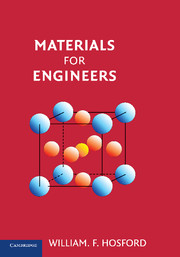Book contents
- Frontmatter
- Contents
- Preface
- 1 Introduction
- 2 Phases
- 3 Diffusion
- 4 Mechanical Behavior
- 5 Mechanical Failure
- 6 Annealing
- 7 Iron and Steel
- 8 Nonferrous Metals
- 9 Casting and Welding
- 10 Solid Shaping
- 11 Polymers
- 12 Polymer Processing
- 13 Glasses
- 14 Crystalline Ceramics
- 15 Powder Processing
- 16 Pottery and Concrete
- 17 Composites
- 18 Carbon
- 19 Fibers, Foams, and Porous Materials
- 20 Electrical Properties
- 21 Optical and Thermal Properties
- 22 Magnetic Materials
- 23 Corrosion
- 24 Modern Manufacturing Techniques, Surface Treatments, and Recycling
- APPENDIX 1 Wood
- APPENDIX 2 Miller Indices for Planes and Directions
- APPENDIX 3 X-ray Diffraction
- APPENDIX 4 Surfaces
- APPENDIX 5 Dislocations
- APPENDIX 6 Avrami Kinetics
- APPENDIX 7 Organic Chemistry
- APPENDIX 8 Average Molecular Weight
- APPENDIX 9 Bond Geometry in Compounds
- APPENDIX 10 Weibull Analysis
- Index
- Conversions
22 - Magnetic Materials
Published online by Cambridge University Press: 05 June 2012
- Frontmatter
- Contents
- Preface
- 1 Introduction
- 2 Phases
- 3 Diffusion
- 4 Mechanical Behavior
- 5 Mechanical Failure
- 6 Annealing
- 7 Iron and Steel
- 8 Nonferrous Metals
- 9 Casting and Welding
- 10 Solid Shaping
- 11 Polymers
- 12 Polymer Processing
- 13 Glasses
- 14 Crystalline Ceramics
- 15 Powder Processing
- 16 Pottery and Concrete
- 17 Composites
- 18 Carbon
- 19 Fibers, Foams, and Porous Materials
- 20 Electrical Properties
- 21 Optical and Thermal Properties
- 22 Magnetic Materials
- 23 Corrosion
- 24 Modern Manufacturing Techniques, Surface Treatments, and Recycling
- APPENDIX 1 Wood
- APPENDIX 2 Miller Indices for Planes and Directions
- APPENDIX 3 X-ray Diffraction
- APPENDIX 4 Surfaces
- APPENDIX 5 Dislocations
- APPENDIX 6 Avrami Kinetics
- APPENDIX 7 Organic Chemistry
- APPENDIX 8 Average Molecular Weight
- APPENDIX 9 Bond Geometry in Compounds
- APPENDIX 10 Weibull Analysis
- Index
- Conversions
Summary
Ferromagnetism
All materials have some interaction with magnetic fields. However, the interaction is strong only in ferromagnetic materials. In this chapter, the term magnetic will mean ferromagnetic. Iron, nickel, and cobalt are the only elements that are magnetic at room temperature, although manganese may act magnetically in some alloys. Several rare earth elements are magnetic at temperatures below room temperature and are useful in certain magnetic alloys. Magnetic materials may be broadly classified as either soft or hard. In soft magnetic materials, the direction of magnetization is easily reversed. These are used in transformers, motors, generators, solenoids, relays, speakers, and electromagnets for separating scrap. Hard magnetic materials are those in which it is difficult to change the direction of magnetization. Uses of permanent magnets include compasses, starter motors, antilock brakes, motors, microphones, speakers, disc drives, and frictionless bearings.
Domains
A magnetic material consists of magnetic domains in which the directions of unbalanced electron spins of individual atoms are aligned with each other. Magnetization is a result of these electron spins. In a material that appears to be not magnetized, the fields of the domains are arranged so that their fields cancel as illustrated in Figure 22.1. The magnetization within the domains is in a crystallographic direction of easy magnetization.
When an external magnetic field is applied, the domains in closest alignment with that field grow as illustrated in Figure 22.2. This causes the magnetization to increase as shown in Figure 22.3.
- Type
- Chapter
- Information
- Materials for Engineers , pp. 216 - 223Publisher: Cambridge University PressPrint publication year: 2008



